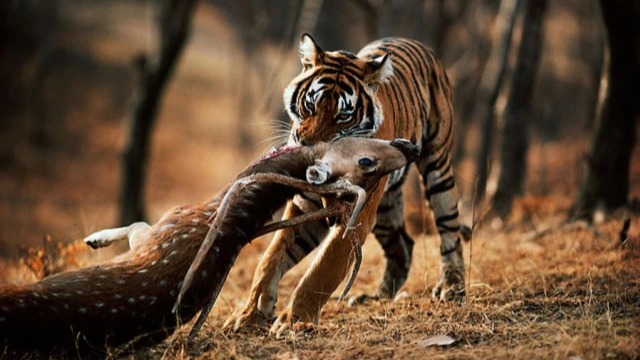We know that there are many ferocious wild carnivores in Africa. Lions, cheetahs, hyenas, etc. compete on the African savannah, but in Asia, tigers are a bit thriving.
For a long time in the past, they have not encountered rivals, they are widely distributed in Asia, and there are 9 subspecies.
Only with the advancement of human science and technology, three of these subspecies have been declared extinct, and the others are basically struggling in the zoo, so our impression of them is a bit distorted, and we always feel that they are “Tie Hanhan”.
Tigers must be terrible. They must have left some deep impressions on Asian residents a long time ago. We are afraid of them in our bones. Tigers are also very large, especially the Siberian tiger. It is the largest tiger in the world, and its body can grow to 3 Meters long.
However, what is interesting is that even if tigers are popular in Asia and are huge in size, even humans are afraid of them, but they have never conquered the Mongolian steppes.
Of course, this is not caused by human factors. In the long history, tigers have never been to Mongolia.
Animals on the Mongolian steppe
Since Mongolia is often associated with the prairie, there must be some herbivorous animals living here. In addition to hares, wild goats, etc., there are also a few strange ones, such as saiga antelopes-a bit like alien creatures, but also There is a musk deer with fangs like a saber-toothed tiger.
However, compared with the African savannah, Mongolia is too barren, and the environment here can be described as extreme.
Similar to Africa, the Mongolian grasslands have very little precipitation, but Mongolia has unusually strong winds in winter. This is one of the reasons for the sparse trees here. Although Africa is also called the prairie, it has luxuriant acacia trees and bushes.
Under the effects of weathering and erosion, a large part of Mongolia’s land has been desertified, mainly distributed in southern and western Mongolia, forming a desert that often appears in history books-Gobi!
Almost 55% of Mongolia’s land is covered by grasslands, mainly in the central and eastern parts of Mongolia, but only about 6% of these grasslands have trees.
The scarcity of trees in Mongolia is also due to human activities, because the felling in Mongolia was also very serious, and the conditions here are not recovering as fast as other places.
Although Africa is extremely short of water like Mongolia, Africa does not lack ponds for wild animals to play in the water and heat up, and Mongolia’s water shortage is really a lack of water storage capacity.
In extreme environments like Mongolia, although mammals have also come here, they are not doing well. You will find that there are basically no large predators in Mongolia, because it is too barren and food is too scarce.
The lack of food is one of the main reasons why large carnivores such as tigers cannot be raised, but you will find that there is no shortage of predators here, including cats-snow leopards and hare, but snow leopards live at higher altitudes. , While the rabbit and the domestic cat are generally of the same size.
The predator who really dominates the Mongolian grasslands may be wolves, but they are only medium-sized wolves.
From the outside, tigers seem to be much stronger than wolves. Since wolves can have enough prey, why can’t tigers do?
In fact, in terms of predation ability, wolves do not lose to tigers. They live in groups and have predation strategies (group animals are often smarter because they need to cooperate with hunting), but tigers fight alone.
Tiger’s predation defects
Tigers have adapted to hunting in the jungle. There is just one thing I want to refute. The color of tigers is not as effective as many people say.
You will find that the color of the tiger is very conspicuous in the jungle, so many people say that its color makes it concealed in the trees a bit wrong, but it is not completely wrong.
This is because tigers do not need to consider this color at all, because almost all non-human mammals are “color blind” and generally have two-color vision.
The conspicuous yellow of the tiger is invisible to its prey. It is more because of this that it hides itself, rather than simply blending the color into the trees.
In order to coordinate with its hiding in the jungle, the tiger has a very thick “air cushion” on its feet, allowing it to approach its prey silently, and then launch a fatal blow.
There are no conditions for tigers to hunt on the Mongolian prairie-hidden and quietly approaching, so their predatory ability will be greatly reduced.
In fact, in terms of speed, the tiger’s instantaneous outbreak should be faster than the wolf (specifically, I did not find the relevant data), but they definitely do not have the endurance of the wolf.
Therefore, even if food permits, tigers cannot replicate the success of wolves on the Mongolian grasslands.
At last
Tigers rarely enter human communities voluntarily. The reason why it entered the village may not be because the environment has improved, but the most likely reason is the shortage of food.
They do not come to disturb us, which is also one of the reasons why they can gain a foothold in Asia (except Mongolia), because we have always been very chasing away large predators like tigers.






